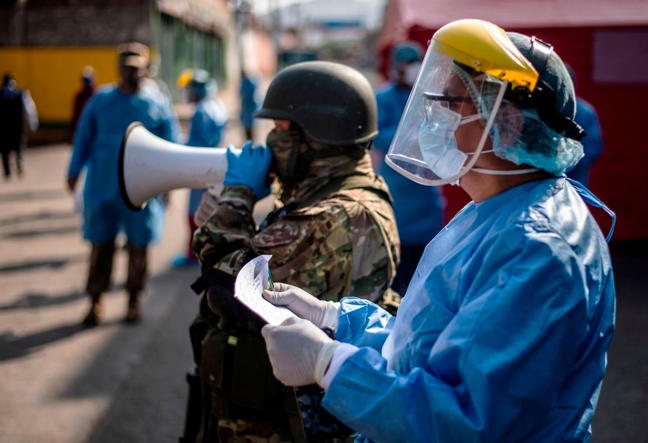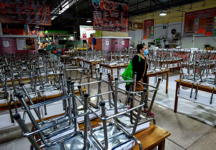
(above) A soldier speaks on a megaphone next to a worker from the Health Ministry during an operation to test employees of the Ciudad de Dios market for the coronavirus in Lima on May 11. ERNESTO BENAVIDES/AFP VIA GETTY IMAGES
Peru’s Civil War Left It Vulnerable to the Pandemic
May 15, 2020 - Original article: foreignpolicy.com
The country should address the worsening coronavirus crisis with policies that will also repair long-standing inequality.
BY MICHAEL ALBERTUS
May 17 marks the 40th anniversary of the start of Peru’s two-decade-long civil war, when the Marxist insurgent group Shining Path kicked off an internal conflict by burning ballot boxes in the rural village of Chuschi. The move was a symbolic rejection of the 1980 national elections that were slated to return Peru to democracy. Today, the country is still living with the war’s consequences as it fights a new enemy: the novel coronavirus.
The civil war, despite ending 20 years ago, has had a long legacy in the country, creating conditions ripe for the spread of contagions like the coronavirus by displacing hundreds of thousands of inhabitants from rural areas where the conflict was most severe and concentrating them in tightly packed settlements in the capital, Lima. Most work in the informal economy and do not have reliable access to government services including health care.
The pandemic is Peru’s gravest threat in decades. To adequately help citizens facing its effects, the country must also address some of the war’s lasting legacies.
The Peruvian civil war was one of Latin America’s most brutal 20th-century conflicts: Parties including militant groups, paramilitaries, and the armed forces killed an estimated 70,000 people from 1980 to 2000. Many of the conflict’s refugees began informal settlements at the outskirts of Lima. They cobbled together houses on the city’s fringes and sought any work they could find. Most joined Peru’s enormous informal sector and received little government support.
Informal urban settlements ballooned in subsequent years and are now among the most serious hot spots for the spread of the coronavirus in the country. Lima has half of the confirmed cases in the country, and the sprawling, poor settlement of San Juan de Lurigancho was the district with the greatest number of cases as of early May. Most inhabitants in these urban areas have never been able to reliably access state health care, nor can they afford to shelter at home for long, as they have spotty access to social safety net programs. This helps account for Peru’s emergence as a center of the coronavirus pandemic in Latin America—second only to Brazil—despite the Peruvian government’s laudable early and vigorous efforts to stem the outbreak of the virus. Peru implemented travel restrictions, mandatory quarantine measures for suspected and confirmed cases, and social distancing measures before most of its regional peers.
=======================
Informal urban settlements ballooned in subsequent years and are now among the most serious hot spots for the spread of the coronavirus in the country.
However, the legacy of the civil war is not entirely to blame. Other subsequent conditions have continued to drive rural displacement and migration to informal urban settlements. One such factor is rural policy. During the war, the military was deployed to rural areas that insurgents used as bases of operation. After a violent and bungled scorched-earth counterterrorism campaign at the war’s outset, the government later shifted to trying to win the hearts and minds of rural constituents in order to facilitate intelligence-gathering and counterinsurgency. It initiated a number of local development projects and increased rural assistance.
My recent research indicates that its efforts paid off particularly well in areas where the government had previously redistributed land to peasants through an enormous land reform program in the 1970s. Guerrilla attacks on communities and the state and overall conflict deaths were systematically lower in these areas.
But rural development policies since the war have been limited and spotty. For instance, many of the millions of land reform beneficiaries from the 1970s still lacked land titles in the 2000s, which consigned them to poverty. A land titling program sought to close that property rights gap, but my research shows that the long years of living with property that lacked secure rights fueled poverty by limiting the ability to sell land or use it as collateral to access credit and inputs that would enhance productivity. The lack of rural support ultimately drew people to cities looking for more opportunity and upward mobility. Furthermore, birth rates remain high in rural areas, generating land pressure and out-migration because of limited opportunities for young adults to make a good living by farming.
The Coronavirus Will Cause
New Crises in Latin America
The region’s economic and political systems were already under strain. In 2020, the virus may push them to a breaking point.
National-level politics since the civil war has further exacerbated inequality. Peru’s postwar presidents lacked both the capacity and incentives to deliver broad-based and coherent social and economic policies that would meaningfully impact citizens’ lives.
Instead, they have garnered support by cultivating local-level political brokers. These brokers dole out minuscule short-term favors to people in exchange for channeling votes to politicians. That generates marginalization, because it alleviates pressure on politicians to invest in big projects and meaningful policies that voters really want, like an effective public health system, dignified public housing, and infrastructure to deliver clean water, paved streets, and electricity. The health system is illustrative. The country spends less than $700 per capita annually on health care, and most of this accrues to upper- and middle-class private sector workers who are less likely to be exposed to the pandemic than the poor.
Instead, national leaders have mostly catered to big business and foreign capital. These powerful interests win valuable mining concessions and juicy government contracts with little competition and favorable terms of trade. Insider lobbying and corruption are common. Every one of Peru’s former elected presidents from Alberto Fujimori on is either jailed or under investigation for corruption, and one killed himself shortly before an arrest was due to be carried out.
Since the pandemic began, Peru’s patchy health care system has betrayed many of its faults. It has a shortage of beds in intensive care units, has little overflow capacity, and is paralyzed by bureaucratic and administrative turnover and the fact that control of public hospitals is divided across multiple government agencies.
As the virus rages in Lima, inhabitants of its informal settlements are packing up and shipping out by the hundreds of thousands. This is reversing the long-standing trend toward urban migration. In the short term, this reverse migration could spread the coronavirus more widely across the country. Rural areas where health care is limited could be especially hard-hit. And ultimately, Peru’s decadeslong rural exodus to informal urban settlements, which made the country vulnerable to the initial spread of the virus, will come back to roost in rural areas. According to the State Density Index developed by the United Nations Development Program, at least 107 of Peru’s 196 provinces have fewer than 10 doctors per 10,000 inhabitants. These are mainly rural provinces, where poverty is widespread.
But migration back to the countryside also presents Peru with an opportunity to address some of the long-standing problems and imbalances sparked by the civil war. It offers a chance for the government to invest more heavily in rural areas, repairing some of the legacies of the violence, which heavily affected the countryside, and making it sustainable for some migrants to remain in smaller outlying cities and rural areas.
Government stimulus programs should target rural areas more generously. Many of Peru’s regions are agriculturally rich and can help to ensure a stable food supply. When the country begins to gradually reopen, the government could offer retraining programs and job opportunities in education, services, and technical trades in secondary cities. And it could double down on subsidies and credits to farmers in the short term while it invests in improvements in rural infrastructure and markets in the medium term.
=======================
Government stimulus programs should target rural areas more generously.
Much of Peru’s agricultural output currently occurs in valleys on the country’s northern and central coastline. But production is widespread throughout the country in valuable crops such as coffee, cacao, quinoa, and tropical fruit. By helping farmers invest in technical improvements, facilitating access to markets, and creating programs to differentiate products for different consumer niches, the government could broaden Peru’s economy and bring more prosperity to the countryside. Presented with a grim reminder of the inequality perpetuated by conflict, Peru should act quickly to stem the effects of the coronavirus by addressing some of the scars of its civil war.
Michael Albertus is an associate professor of Political Science at the University of Chicago. He is author, most recently, of Authoritarianism and the Elite Origins of Democracy.
